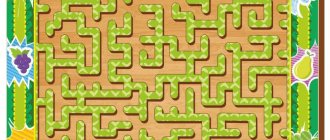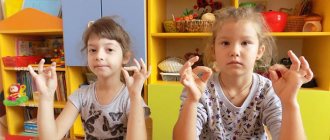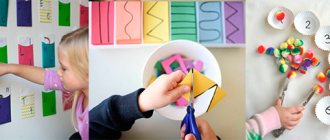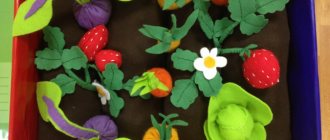Mechanism and types of perception
For the full development and effective learning of a child, a sufficient level of development of perception is necessary. It is the basis for the formation of other cognitive processes (memory, attention, thinking, speech and imagination). How does the process of perception occur?
- The world around us consists of various objects and phenomena that can be seen, heard, touched, tasted, smelled.
- With the help of our senses we learn about what an object is. For example, an orange has the following properties: round, orange, smooth, with small dimples on the peel, sour, and has a specific citrus smell.
- Information from the senses enters the brain, where individual sensations are combined into a holistic “picture” - perception.
- Perception is greatly influenced by accumulated life experience. If a child has already seen and eaten an orange, he does not need to taste it to guess what it is.
Classification of types of perception:
- Visual perception allows you to obtain a visual image of an object, as well as study its details;
- Auditory perception makes it possible to understand speech, recognize various sounds of nature, household noises and hear music;
- Tactile perception - cognition of objects through touch;
- Olfactory perception – recognition of odors;
- Taste perception – receiving information from taste buds (perception of sweet, salty, sour and bitter).
Most experts believe that each of us has a leading channel for receiving “data” about the world (usually vision, hearing or touch). Pay attention to the form in which your baby absorbs information better - this should be the main one in his learning.
Methods for developing different types of perception
Here are several methods for developing perception of different types.
Size, color and shape
In this case, children are asked to take out objects of only one color from the boxes. Or suggest taking out only square objects, or only round ones. You can prepare boxes painted in different colors, and in them the child must put objects of the color in which the box is painted.
What's lost?
In this game, not only vision and attentiveness work, but also thinking. The child is asked to look at a picture showing different objects. But they are not finished yet. For example, a bicycle is missing a wheel, and a house has no windows. The child must tell what is missing.
Smell and guess
Smell works in this game. The child is blindfolded, in front of him are vegetables and fruits, and other products that the player must name, guided by smell.
Magic sound
A game that awakens the imagination and ears. Child with closed eyes. The presenter plays sounds, including the audio system: the sound of rain, the sound of a steam locomotive, the chirping of birds, etc. The child names who the sounds belong to.
Tactile riddle
There are objects in the container. The child, without looking, must determine by touch what it is. Objects must be of different sizes, shapes, smooth or rough.
Peculiarities of perception in early preschool age (3-4 years)
The perception of 3-4 year old children is characterized by specificity and lack of clarity. The main parameters of perception in early preschool age are color, shape and size. Most often, children pay attention to the most striking of these signs, and the rest of the details are guessed by them. For example, seeing buttons with numbers on the TV remote control, children often decide that it is a telephone. It is interesting that three-year-olds do not recognize even the closest people if they are dressed in carnival costumes. At this age, children clearly distinguish primary colors (red, yellow, blue, green). Little-known shades are perceived as unimportant signs, and therefore are often simply ignored. However, kids learn quickly and remember everything on the fly. The more color standards you introduce your child to, the brighter the baby’s perception will be. Sometimes children evaluate the color characteristics of objects as “beautiful” and “ugly”, so in drawing you can see the child’s color preferences, and not real images of objects.
The properties of objects for younger preschoolers are inseparable from the things themselves, so they are firmly fixed in perception. For example, a baby knows that a cucumber is always green, and can call zucchini, avocado, and green beans cucumbers.
In children of this age, their perception of space is formed through actions with objects. A 3-year-old child is just beginning to distinguish between the concepts of “far” and “close”, so he has difficulty assessing the size of distant objects. For example, looking at the panorama of the city, a child may well think that the houses are toy. To develop the baby’s spatial understanding, you need to pay his attention to his own body (the child will quickly remember that the legs are below, the head is above, and the arms are at the side), and also more often give the child requests indicating the direction (for example, “turn right” , “take the candy from the top shelf” and so on).
How do children of middle preschool age (4-5 years old) perceive the world?
By the age of 5, children achieve significant success in their ability to perceive various parameters of the world around them:
- There are 7 or more colors;
- Have an idea of light and dark tones, “warm” and “cold” shades;
- Know the basic geometric shapes (circle, square, triangle, rectangle);
- Can compare objects by size (large, smaller, small);
- They begin to form the concept of time (today, yesterday, tomorrow, minutes, hours, days, weeks), but they are not yet able to apply knowledge about these abstract concepts into the life of a four-year-old;
- The perception of other people depends on their popularity in society and their relationship with the baby. Mom will always be perceived by the baby as the kindest and most beautiful.
Peculiarities of perception in older preschool age (5-7 years)
In older preschool age, as before, visual sensations dominate perception. Auditory perception begins to actively develop: children are able to identify sounds in words, recognize familiar musical compositions, and feel the tempo and rhythm of a piece. Six-year-old children are well oriented in space (they practically do not confuse “right” and “left”, perceive distances between objects quite accurately, and can navigate plans and diagrams). The perception of time periods (minute, hour, day, and so on) depends on how often parents mention them in communication with their children. If you give your child tasks in which time is one of the guidelines (for example, “draw as many circles as possible in a minute” or “you need to brush your teeth for 2 minutes”), gradually it will no longer be so incomprehensible to the child.
The leading channel of perception for most older preschoolers is vision. At the same time, other types of sensitivity (especially auditory and tactile) are also actively developing.
Peculiarities of perception in older preschoolers
Senior preschool age is marked by the presence of formed spatial representations. The child is well oriented in space, perceives distances and relationships between objects, and is able to visually model part of a specific room. He is also able to construct a model of the plot of a story or fairy tale.
The future schoolchild is already able to evaluate such an abstract concept as time, as well as see the world around him from an aesthetic point of view. It is these two areas that require the most attention.
Perception of time
The main features of perception in children of senior preschool age are the awareness of the combination of space and time. However, the inability to hear or touch these quantities leads to their prolonged recognition.
A child of 5-6 years old is able to remember time periods: yesterday, today, tomorrow, minute, hour, but there are no skills in using these concepts. The uniqueness of the perception of time is due to the fact that the child does not have the opportunity to manipulate it in a direction, and the terms are simply words that do not have a visual expression.
At this age, time indicators of the sequence of events are still poorly differentiated - yesterday, tomorrow, the day after tomorrow. The future tense is already realized, but the past causes difficulty. Preschoolers are happy to say who they will be when they grow up, what they will have, what they will do. They perceive the past discretely and emerge in the images of remembered events.
However, older preschoolers are already able to understand how to define the present tense. It's time to teach your child to tell time using a clock with arrows.
Adults will help the child perceive small periods of time if they correlate his activities with the time interval: draw a house with a garden in 10 minutes, sit at the table in 3 minutes, brush your teeth in 1 minute.
Aesthetic perception
But aesthetic perception blossoms “lushly.” In older preschool age, every child is a creator. Children sculpt, draw, design. The listed types of activities help them understand the world better.
Much of the credit for this activity goes to visual perception. An older preschooler learns to examine objects holistically, tracing the outline and isolating details.
This information becomes a model that the child follows in his drawing and modeling.
If a 5-year-old child’s judgment about aesthetics is determined by appearance, and objects are evaluated according to the “like or dislike” principle, then at 6-7 years old a preschooler pays attention to artistic composition and color compatibility. For example, in a painting he is already able to capture characteristics that are not on the surface, which the artist put into the content.
The task of parents and educators is not just to inform the child about the beauty of this or that object. It is important to explain in clear words what exactly ensures the aesthetics of a phenomenon, the relationship between individual features and the overall result.
Regular activities of this nature help to cultivate a sense of beauty in a little person. He will learn to see beauty in the sound of drops on glass or falling leaves.
Games and exercises for developing perception in preschoolers
Play is the leading activity in preschool age. This is why exercises and games are an effective and fun way to develop children's perception.
- Sorting by color, shape, size. Items for sorting can be any available materials: toys, lids, construction parts, cubes, buttons, cereals, pencils, etc. You can organize the game in various ways: placing objects in bowls, “hiding” an object (arranging objects so that they blend into the background), throwing objects into holes of the desired color/shape/size.
- "What is missing". This exercise develops visual perception, thinking and attention to detail. Draw several objects or animals on a piece of paper, but do not finish drawing them. One or more essential features of the objects must be missing (for example, a hare without ears, a table without legs, a car without wheels), and the baby’s task is to say what is missing in the picture.
- "Confusion." Show your child a picture with the contours of familiar objects superimposed on each other. The child must name everyone who is depicted on it.
Regular exercises will help your child develop a high level of various types of perception.
- Puzzles and cut-out pictures. These games, in which the child needs to assemble a whole picture from pieces, are excellent for developing visual perception.
- "Guess by the smell." From available ingredients you can create a whole aroma set (for example, garlic, coffee, cinnamon, berries, cucumber, lemon, chocolate, and so on). Ask your baby to close his eyes and guess the object by smell. You can also invite your child to draw what he associates this or that scent with.
- “Whose sound?” An adult hides behind a screen and uses objects to make various sounds: rustling a bag, tearing paper, knocking with spoons, ringing a bell, pouring water, and so on. The baby must guess which object each sound corresponds to.
- "Magic bag" For this game you will need an opaque bag and small objects of various shapes and textures. Based on his tactile sensations, the baby should pull out the thing that you describe to him.
Ways to develop the perception of preschoolers
In preschool age, the leading activity is play. It is in this form that children learn and develop the necessary functions in the best way.
Didactics presents many games for the development of perception that will help parents or educators engage with their children.
- Droplets – teach how to combine objects based on color criteria. The essence of the task is that you need to put circles of the corresponding shades into containers.
- Umbrellas - form an understanding of the shape and color of objects. To play you need 4 umbrellas of primary colors and cardboard geometric shapes. The teacher reports that it is raining, it is urgent to hide the circles and triangles under umbrellas of different colors.
- Bag of secrets - allows you to identify an object based on tactile sensations. An opaque bag is filled with small toys. The child, without looking, must describe what came into his hand.
Similar games are played to develop the ability to recognize an object or item by smell or sound.
Regular classes to develop perception in preschoolers will ensure further effective cognitive advancement and the formation of a holistic, moral personality. Such a person will most likely have unconventional thinking and a high level of creativity.
conclusions
At preschool age, children experience a colossal leap in mental development, because during this period all cognitive processes are actively formed. Perception is the basic mental process on the basis of which all others (attention, thinking, speech, memory and imagination) are formed. Over the course of several years, children go from direct sensory perception to the ability to form a generalized idea of objects. If initially a child learns to recognize and evaluate what is in front of him at the moment, based on his own sensations and experience, then in older preschool age the level of development of perception allows him to purposefully study objects or phenomena, highlighting their properties. It is necessary to pay enough attention to the development of perception in children, because the child’s ability to learn largely depends on its level.
Activities that promote differentiated color perception
Read more: The importance of color perception in human life
Activities that promote differentiated perception of color (using the example of the older age group)
Plan
Introduction
1. The importance of color perception in human life
2. Peculiarities of color perception by preschool children
3. Level of color perception in children of this age group
4. Conditions for the formation of color perception in preschool children
Conclusion
List of used literature
Introduction
Color as an object of study has always attracted scientists, psychologists, art historians, and naturalists. It is one of the most powerful means of expressiveness for painters. A well-developed sense of color helps to more fully feel the beauty of the world around us, the harmony of colors, and feel spiritual comfort.
The task of the kindergarten teacher is to introduce preschoolers to “sensory standards” in the field of color during the learning process, to teach them to use them as systems of sensory measures or standards for analyzing the environment.
Since ancient times, people have attached special meaning to color. It was believed to have magical powers because each color evoked a special reaction. Color can please and cause irritation, anxiety, feelings of melancholy or sadness. In other words, color has an emotional effect on people. Some colors calm the nervous system, while others, on the contrary, irritate. Green, blue, blue have a calming effect, and purple, red, orange, yellow colors have a stimulating effect. Japanese teachers have determined that color perception makes it possible to most widely develop a child’s senses, his natural taste (thinking, creative abilities), which in turn affects the overall development of a person.
German art historians came to the conclusion that color is a means of directly reflecting the world of a child’s experiences and emotions. Thus, Fitu S. believes that the task of a child-oriented art education lesson should be to develop the child’s color senses through the skillful use of visual aids in color science.
In our country, the problem of children’s perception of color was given much attention by such famous teachers and psychologists as L.A. Wenger, I.D. Venev, G.G. Grigoriev, Z.M. Istomina, V.S. Mukhina, E.G. Pilyugina, N.P. Sakulina, A.M. Fonarev and others. They came to the conclusion that the use of color and “sensory standards” in fine arts classes is of great importance not only for the development of color discrimination, but also for the formation of abstract-imaginative thinking.
The fact that color influences the emotional state is evidenced by the reactions of a preschool child to objects of different colors. Thus, scientific data obtained in studies of recent decades (L.A. Venger, I.D. Venev, Z.M. Istomina, E.G. Pilyugina, A.M. Fonarev, etc.) showed that children from the very first weeks and months of life are able to distinguish objects of different colors. Already at the age of four, children perceive color in book illustrations and in their drawings as a means of decoration.
The position on the use of color as an expression of the child’s emotional attitude towards what is depicted, put forward by E.A. Flerina, is confirmed by research by V.A. Ezineeva, A.V. Kompantseva, V.S. Mukhina and others. A child is able to consciously use color to convey his attitude to the depicted image: with bright, clean, beautiful colors he usually depicts his favorite characters and pleasant events, and with dark (“dirty”) colors he usually depicts unloved, evil characters and sad events. In the studies of the famous teacher V.S. Mukhina noted that when depicting pleasant events, children prefer warm tones, and cold ones when depicting unpleasant events. As the child masters visual experience and learns about the world around him, the color in a child’s drawing becomes more realistic (research by V.S. Mukhina, N.P. Sakulina, E.A. Flerina, etc.).
In kindergarten practice, children’s mastery of color is organized with the aim of solving two interdependent tasks. On the one hand, the formation of a sense of color is an integral part of sensory education, aimed at developing children’s ability to navigate the world around them. On the other hand, by mastering the standard system of properties and characteristics of objects (including generally accepted standards of color) directly in the visual arts, children learn to appropriately reflect these properties and characteristics in the drawing.
At the same time, the assimilation of color standards (as well as shapes) has a dual impact on the development of a child’s perception. As noted by V.S. Mukhina, standards determine, on the one hand, the nature of the development of perception: the child learns to classify objects according to their properties. However, on the other hand, in the child’s perception the canonized normativity of colors and other qualities characterizing the object is fixed, and with direct perception this object is correlated with the learned standard, while its individual characteristics may not be recorded. V.S. Mukhina considers it necessary to expand the canonized normativity (standard) of perception in the context of children learning “artistic languages” when learning to draw. This, in her opinion, will enrich perception and at the same time free the child from simplified stereotypical normativity and provide the opportunity to receive aesthetic pleasure from the beauty of a particular object or phenomenon.
Read more: The importance of color perception in human life
Information about the work “Activities that promote differentiated perception of color”
Section: Pedagogy Number of characters with spaces: 20517 Number of tables: 0 Number of images: 0
Similar works
Correction of visual perception of children with visual impairments in design classes
212769
18
7
... is also the child’s desire to show the results of his work to an adult, to earn praise. Chapter 3. Experimental study of the possibilities of design classes for correcting the visual perception of children with visual impairments 3.1 Ascertaining stage In order to identify the effectiveness of design in correcting the visual perception of preschool children with ...
Using didactic games to form ideas about sensory standards of color in children of primary preschool age
122627
2
2
... about sensory color standards. — in the course of experimental work, pedagogical conditions for the formation of ideas about sensory standards of color in children of primary preschool age were identified and scientifically substantiated if: a set of didactic games is selected; conditions have been created for the effective use of didactic games. — during their use, we found that at each stage...
Development of spatial concepts in construction classes for older preschoolers
145753
0
2
... insufficient orientation in parts of their own body and insufficient fine motor skills. Chapter II. Design classes in preschool educational institutions as a factor in the development of spatial representations of older preschoolers with mental retardation 2.1 Survey This analysis was carried out on the basis of an experimental study of children with mental retardation of senior preschool age...
Analysis of speech therapy technologies that help eliminate dyslexia in children of primary school age with special needs development
195132
22
8
... twice as bad as a normal child. Speech underdevelopment is manifested in a significant deviation from the norm in the formation of phonetic concepts underlying sound analysis. Children of primary school age with speech underdevelopment are characterized by impaired reading expressiveness, lack of necessary pauses defined by punctuation marks, failure to observe pauses at the end of sentences, abrupt...








